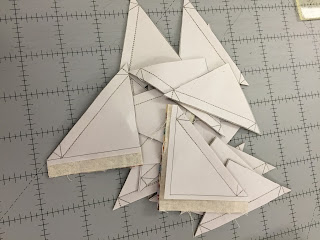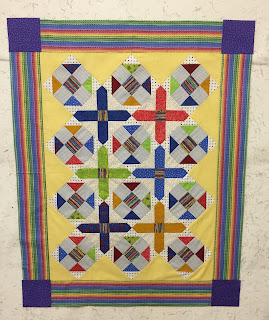First, you get to decide if you want to paper-piece them as Sue did. I chose to go with this method because I find it fast and all the cutting math is already done. If you prefer to make Half Square Triangles with regular piecing, you certainly can.
Second, you get to decide if you want to make pinwheels at all. One of the members of my small group said she really doesn't like pinwheels. That's fine. ANY 3" finished shape will work in place of 3" finished pinwheels. How about:
Monkey Wrench blocks:
Nine Patches:
Other options could be: Quarter Square Triangle blocks, Four Patches, Friendship Star, any block that can be made easily in a 3" size. It's your quilt, you decide.
I am paper piecing the pinwheel blocks AND the flying geese borders that come next. I am using more than a few fabrics, using up what I have, some fabrics are smaller than fat quarters, some are yardage. I decided to figure out the best way to cut BOTH the pinwheel fabrics AND the flying geese fabrics. This way I could handle all these fabrics once and cut both sets of borders at the same time.
For Month 7 we'll be making 40 Pinwheels. In Month 8, we'll make the remaining 40 AND start the Flying Geese. I decided to CUT them all now. If you are using the Kit, you will follow the fabric selections listed in the pre-cutting instructions. If you are using your own fabric, use whatever colors you like.
Background: From Width of Fabric (about 41-42") we can get four 8" x 10" rectangles if we cut the strips 8" wide. Month 7 requires 2 strips, Month 8 requires 2 more so I cut 4 strips 8" wide. They were sub-cut into 10" lengths, giving me ALL sixteen background pieces I needed (8" x 10") for ALL the pinwheels, with very little extra leftover.
Pinwheel Fabrics: For these I found it was better to cut the strips 10" wide because of the sizes needed for the flying geese borders in Months 8 and 9. For Month 7 pinwheels we need 8 colors cut 8" x 10"; we need the same amount for Month 8--for a total of 16 pieces 8" x 10". I cut each fabric 10" wide, then sub-cut into two 8" x 10" rectangles. Sixteen 8" x 10" rectangles = ALL the pinwheel fabrics needed.
How do you cut a strip of yardage 10" wide if you don't have a 10" wide ruler?
Here is everything cut for the Pinwheel Borders:
After cutting the two rectangles 8" x 10" from eight fabrics needed for the pinwheels, I cut the fabrics needed for the flying geese borders. Now I am getting ahead here so if you prefer to wait and cut the flying geese fabrics in Month 8, just put your eight fabric strips that are 10" wide aside for now.
If you want to keep cutting for the flying geese borders, you will need 5" squares of color for the geese--a total of 45 of those. The instructions call for 8 fabrics for the geese, just like the pinwheels. Three fabrics are cut into five 5" squares, five fabrics are cut into six 5" squares--this will give you the 45 squares needed.
Because I cut the color fabrics 10" wide, it was easy to cut 5" squares from the remaining fabric, here are four being cut, there are 2 layers of fabric here:
I cut one additional 5" square of this green and had the 5 squares of that green I needed.
After all the colors were cut for the flying geese, I kept going and cut the background needed for Month 8 and 9 too--the geese background. Again, if you want to wait, stop reading and wait for next month. You need 180 squares of background, 3" square, for the flying geese borders. I decided to use all the the background fabrics I have used so far before cutting any new background. That worked well as they are all similar tan tone-on-tone fabrics. It feels good to use up some of these fabrics that have lived in my closet for years and when the flying geese borders are made they will be more interesting to me.
Here is everything cut for the Flying Geese Borders:
There are more than 8 different fabrics because I was using up what I had, but the colors are similar. For example, there are 3 different golds, a total of 5 squares. All 3 of those have been used earlier in this quilt.
It took less than 2 hours to cut out all these fabrics, including the time to figure out the cutting plan, dig out and press my fabric and take photos. It felt great to have ALL this cutting done at one time.
Now it's on to the paper piecing. Remember to make your stitch length smaller, 1.5 works for me. If you need reminders on the basics of paper piecing, you might want to review Month 1 here.
Pair a background and fabric rectangle, right sides together, place the paper pattern on top and you are ready to begin sewing. NOTE: I trimmed the margin of the paper down a bit, not completely to the solid line, but close.
If you start sewing where indicated in this photo below, you can sew all the seams in one continuous, non-stop line. Pivot at each corner. When you get back to where you started, pivot and do the long line that remain, both sides. Try to sew on the dashed line, or slightly to the left of it. Sewing on the outside of the dashed line will make your HST units slightly small:
 |
| Cut the long lines, I was careful to save the extra chunk at the bottom |
 |
| Separate all the squares |
 |
| Cut the squares in half, trim off the outer edge excess too |
 |
| If you trim these solid lines now there will be no dog ears to trim off later |
Gently remove the paper, mine came off easily. Press toward the dark fabric. Check to be sure your HST units are 2" unfinished. With luck, you won't need to trim.
Sew the top half to the bottom half and then decide how you want to press the center seam. You can press in a spiral, distributing the bulk around the center, as I did. You can press in one direction. You could also press the seam open, though I rarely do. Decide which you prefer.
VERY IMPORTANT NOTE: It is important that all the units are sewn the same way, BOTH MONTHS, and that the borders are all sewn with pinwheels going in the same direction. Make sure your pinwheels all SPIN in the same direction.
After you have the top and side borders sewn together, you are done for this month.
Let's Quilt!
Barbara
















































